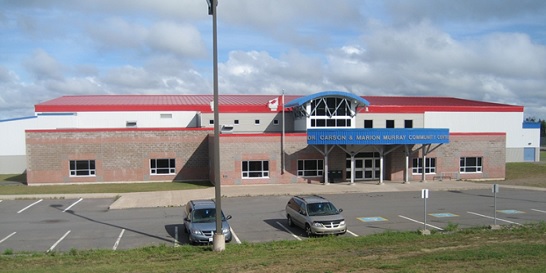
After the roof collapsed on the Springhill Arena in 2001, the Town of Springhill constructed a new multi-purpose community centre to accommodate sports, recreation, culture, tourism and business activities. The centre is the largest facility in Atlantic Canada to rely on geothermal energy for heating and cooling. A particularly innovative feature is the use of geothermal energy to chill the arena ice. A piping system draws warm water from a nearby abandoned coal mine, and heat exchange technology generates power that freezes the ice. Waste heat created during this process is used to provide radiant heat to the building.
This project saw the completion of two out of three planned phases of construction. The first phase includes an arena with an NHL-sized ice surface, seating for 800, a walking track, five dressing rooms, a room for officials, storage facilities, a canteen and kitchen, a meeting room and town administrative offices. The second phase includes a 3,100 square foot multipurpose room and teen centre. The third phase, still in the planning stages, will include a 4,285 square foot community gymnasium with two extra dressing rooms.
Results
| Environmental | Economic | Social |
|---|---|---|
|
|
|
Challenges
- The site originally proposed for the community centre (the site of the old Springhill Arena) was unsuitable because it was built on top of old mine workings, and a new location had to be found that was close to a good source of mine water.
- Construction costs were significantly higher than originally projected, because of market factors and underestimation, and some features had to be redesigned.
- Finding a well with enough water to meet the facility's needs required five exploratory drillings, and designing the system to circulate the water was complex.
Lessons learned
- Consider using waste heat from the ice-making process to heat the building, maximizing the resource.
- Include contingency funds in the project budget in case contractors underestimate expenses or market fluctuations affect prices and timelines.
- When designing a geothermal system that uses mine water for energy, consider the building's proximity to the resource. Mine water could be pumped to the building, or heat could be extracted at the source.
Partners and Collaborators
- The planning, building and fundraising committees included town staff, community members, businesses, seniors and youth, school representatives and provincial government representation. Nova Scotia Department of Health and Wellness, Active Living Branch.
Project Contact
Brian Herteis
Director of Engineering and Public Works
Town of Springhill, NS
T. 902-597-2496
Want to explore all GMF-funded projects? Check out the Projects Database for a complete overview of funded projects and get inspired by municipalities of all sizes, across Canada.

